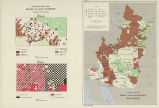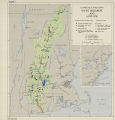| OCR Text |
other agencies may furnish is generally inadequate to the need. The difficulties of relocating have caused prop- erty owners in proposed reservoir areas to oppose the adoption of worthwhile reservoir projects. This same knowledge has also led some owners to increase the price of their land above the normal market value to compensate for anticipated loss. The results are a higher price for the flowage area than otherwise would be required and delays and difficulties in negotiating purchases. The land acquisition program at Allatoona Reser- voir involved 429 landowners and 47,768 acres of land. Of this total acreage slightly more than half was purchased from the Georgia Power Co. None of this land was in cultivation. Of the remaining 23,800 acres, 5,162 were cleared land. The rest of the land was steep, wooded, and under-developed. Acquisition of the lands proceeded over a consider- able period, and did not give rise to extreme infla- tion of land prices in the surrounding area. The aggregate area of the 27 reservoirs included to complete the present basin-wide plan of the Corps of Engineers is about 283,000 acres. Total land acreage acquired will be somewhat greater since this figure represents the area which will be permanently flooded. In constructing these projects, similar problems of land inundation will be encountered. Howell Mill Shoals Reservoir, particularly, will in- undate a more highly developed and thickly settled area than did Allatoona. Conclusions Present procedures for property acquisition for Federal reservoir projects often result in hardships to the affected property owners, excess costs to the Federal Government, and delays and opposition to the Federal program. The procedures could be im- proved, both from the standpoint of the property owners and the Federal Government, if sufficient funds were available to initiate an orderly program of land acquisition at an early stage in project de- velopment and if the property owners were assured of Federal assistance in resettlement. Adequate assistance in relocation would prevent much of trae hardship accompanying resettlement. Relocation in the case of flood control projects might well be in areas for which flood protection would be provided. 2. Highway Relocation The Problem Replacement of highways and bridges, and alter- ation of highway bridges. The Situation In developing the water resources of the Ala- bama-Coosa Basin, differences of opinion arose be- tween State and local highway officials and the Corps of Engineers as to what constitutes equity in the relocation or replacement of highways and bridges in a reservoir area. Until recently, the basic position of the Corps has been that local in- terests are entitled, at Federal expense, to a sub- stitute facility equal, as nearly as possible, in kind and quality to that eliminated; if facilities of higher quality and cost are desired by local interests, the excess cost should be assessed against them. The principal highway problem in this basin is that of bridge alteration. Existing law prescribes that the plans for any bridge to be constructed over navigable waters of the United States must be ap- proved by the Chief of Engineers and the Secretary of the Army before construction of such bridge is begun, and that, if the Secretary of the Army de- termines at any time that such bridge unreasonably obstructs free navigation, he may require any alter- ation needed to render navigation through or under the bridge reasonably free and unobstructed. There are 14 highway bridges over the navigable portions of the Alabama and Coosa Rivers. Except for certain of the older bridges, the plans for each bridge were approved as meeting the clearance re- quirements of navigation at the time it was con- structed. Estimates presented indicate that these bridges cost about 25 percent more to meet naviga- tion requirements than they would have cost with- out regard to those requirements. The higher water levels resulting from construction of the dams in this basin may require changes in some of those bridges. Changes required to meet contemplated navigation requirements will add considerably to the cost of such alterations. Highway officials con- tend that such added costs to meet the needs of navigation should be met by the United States. Some highway relocation because of reservoir construction also will be necessary. Preliminary estimates of the cost of relocating highway facilities 564 |


























































































































































































































































































































































































































































































































































































































































































































































































































































